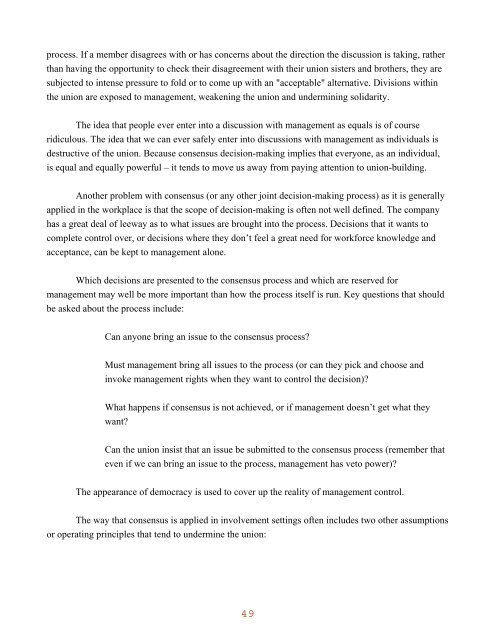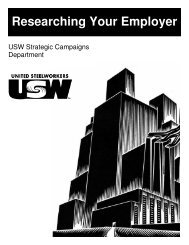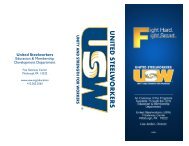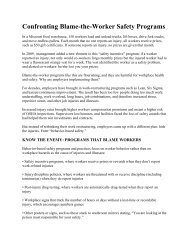Union Approach to Health and Safety: - United Steelworkers
Union Approach to Health and Safety: - United Steelworkers
Union Approach to Health and Safety: - United Steelworkers
Create successful ePaper yourself
Turn your PDF publications into a flip-book with our unique Google optimized e-Paper software.
process. If a member disagrees with or has concerns about the direction the discussion is taking, rather<br />
than having the opportunity <strong>to</strong> check their disagreement with their union sisters <strong>and</strong> brothers, they are<br />
subjected <strong>to</strong> intense pressure <strong>to</strong> fold or <strong>to</strong> come up with an "acceptable" alternative. Divisions within<br />
the union are exposed <strong>to</strong> management, weakening the union <strong>and</strong> undermining solidarity.<br />
The idea that people ever enter in<strong>to</strong> a discussion with management as equals is of course<br />
ridiculous. The idea that we can ever safely enter in<strong>to</strong> discussions with management as individuals is<br />
destructive of the union. Because consensus decision-making implies that everyone, as an individual,<br />
is equal <strong>and</strong> equally powerful – it tends <strong>to</strong> move us away from paying attention <strong>to</strong> union-building.<br />
Another problem with consensus (or any other joint decision-making process) as it is generally<br />
applied in the workplace is that the scope of decision-making is often not well defined. The company<br />
has a great deal of leeway as <strong>to</strong> what issues are brought in<strong>to</strong> the process. Decisions that it wants <strong>to</strong><br />
complete control over, or decisions where they don’t feel a great need for workforce knowledge <strong>and</strong><br />
acceptance, can be kept <strong>to</strong> management alone.<br />
Which decisions are presented <strong>to</strong> the consensus process <strong>and</strong> which are reserved for<br />
management may well be more important than how the process itself is run. Key questions that should<br />
be asked about the process include:<br />
Can anyone bring an issue <strong>to</strong> the consensus process?<br />
Must management bring all issues <strong>to</strong> the process (or can they pick <strong>and</strong> choose <strong>and</strong><br />
invoke management rights when they want <strong>to</strong> control the decision)?<br />
What happens if consensus is not achieved, or if management doesn’t get what they<br />
want?<br />
Can the union insist that an issue be submitted <strong>to</strong> the consensus process (remember that<br />
even if we can bring an issue <strong>to</strong> the process, management has ve<strong>to</strong> power)?<br />
The appearance of democracy is used <strong>to</strong> cover up the reality of management control.<br />
The way that consensus is applied in involvement settings often includes two other assumptions<br />
or operating principles that tend <strong>to</strong> undermine the union:














